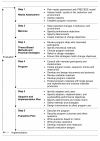The impact and process of a community-led intervention on reducing environmental inequalities related to physical activity and healthy eating - a pilot study
- PMID: 21910896
- PMCID: PMC3179454
- DOI: 10.1186/1471-2458-11-697
The impact and process of a community-led intervention on reducing environmental inequalities related to physical activity and healthy eating - a pilot study
Abstract
Background: There is growing recognition that a sedentary lifestyle is being driven, at least in part, by environmental factors that affect individuals' physical activity choices and health behaviours. In other words, the environments in which we live, and with which we interact, have become ones that encourage lifestyle choices that decrease physical activity and encourage over-consumption of foods. However, evidence from community-led interventions to change local neighbourhood environments to support physical activity and healthy eating is lacking. This article summarises the research protocol developed to evaluate a community-led intervention "My Health Matters" aimed at reducing health inequalities relating to increasing physical activity and healthy eating as defined by community members themselves.
Methods/design: This study includes three of the most deprived electoral wards in Stoke-on-Trent. In each of these areas, environmental factors including proximity of physical activity spaces, greenspace and leisure facilities, neighbourhood connectivity and walkability, land-use-mix and population density, traffic, safety and crime, and food outlets will be mapped using Geographical Information Systems (GIS). A community postal survey of randomly selected addresses assessing environmental characteristics relating to physical activity, perceived health status, social capital, fruit and vegetable consumption and levels of physical activity will be undertaken (baseline and at 2 year follow-up). Based on baseline findings an intervention will be designed and implemented over a 2 year period that includes the following; use of community participatory research to build effective community partnerships; use of partnership consensus to identify, prioritise and design intervention(s) related to specific health disparities; recruitment of local residents to help with the delivery and sustainability of target intervention(s); and the development of local systems for ongoing monitoring and evaluation of the intervention(s).
Discussion: A community-led and multidisciplinary approach to modifying environmental factors that support and reinforce healthful behaviours may be more successful than focusing on individual behaviour change as this approach does not exclusively rely upon individual will and capacity.Study findings will be collated in 2012 and, if successful in improving levels of physical activity and healthy eating, will help to inform the design of a larger area-based, cluster randomized controlled trial to determine effectiveness.
Figures
References
-
- World Health Organisation Europe. A Healthy City is an Active City: a physical activity planning guide. Geneva: WHO; 2008.
-
- Saelensminde K. Cost-benefit analyses of walking and cycling track networks taking into account insecurity, health effects and external costs of motorized traffic. Transportation Research Part A. 2004;38:593–606. doi: 10.1016/j.trb.2003.05.001. - DOI
Publication types
MeSH terms
LinkOut - more resources
Full Text Sources
Medical


